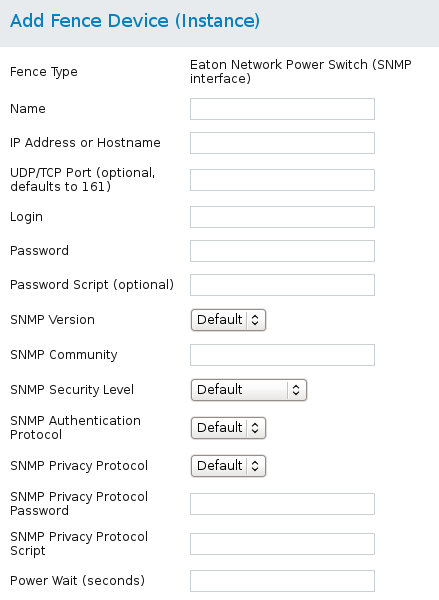Ce contenu n'est pas disponible dans la langue sélectionnée.
4.7. Eaton Network Power Switch
Table 4.8, “Eaton Network Power Controller (SNMP Interface) (Red Hat Enterprise Linux 6.4 and later)” lists the fence device parameters used by
fence_eaton_snmp, the fence agent for the Eaton over SNMP network power switch.
| luci Field | cluster.conf Attribute | Description |
|---|---|---|
| Name | name | A name for the Eaton network power switch connected to the cluster. |
| IP Address or Hostname | ipaddr | The IP address or host name assigned to the device. |
| UDP/TCP Port (optional) | udpport | The UDP/TCP port to use for connection with the device; the default value is 161. |
| Login | login | The login name used to access the device. |
| Password | passwd | The password used to authenticate the connection to the device. |
| Password Script (optional) | passwd_script | The script that supplies a password for access to the fence device. Using this supersedes the parameter. |
| SNMP Version | snmp_version | The SNMP version to use (1, 2c, 3); the default value is 1. |
| SNMP Community | community | The SNMP community string; the default value is private. |
| SNMP Security Level | snmp_sec_level | The SNMP security level (noAuthNoPriv, authNoPriv, authPriv). |
| SNMP Authentication Protocol | snmp_auth_prot | The SNMP authentication protocol (MD5, SHA). |
| SNMP Privacy Protocol | snmp_priv_prot | The SNMP privacy protocol (DES, AES). |
| SNMP Privacy Protocol Password | snmp_priv_passwd | The SNMP privacy protocol password. |
| SNMP Privacy Protocol Script | snmp_priv_passwd_script | The script that supplies a password for SNMP privacy protocol. Using this supersedes the parameter. |
| Power wait (seconds) | power_wait | Number of seconds to wait after issuing a power off or power on command. |
| Power Timeout (seconds) | power_timeout | Number of seconds to continue testing for a status change after issuing a power off or power on command. The default value is 20. |
| Shell Timeout (seconds) | shell_timeout | Number of seconds to wait for a command prompt after issuing a command. The default value is 3. |
| Login Timeout (seconds) | login_timeout | Number of seconds to wait for a command prompt after login. The default value is 5. |
| Times to Retry Power On Operation | retry_on | Number of attempts to retry a power on operation. The default value is 1. |
| Port (Outlet) Number | port | Physical plug number or name of virtual machine. This parameter is always required. |
| Delay (optional) | delay | The number of seconds to wait before fencing is started. The default value is 0. |
Figure 4.7, “Eaton Network Power Switch” shows the configuration screen for adding an Eaton Network Power Switch fence device.
Figure 4.7. Eaton Network Power Switch
The following command creates a fence device instance for an Eaton Network Power Switch device:
ccs -f cluster.conf --addfencedev eatontest agent=fence_eaton_snmp ipaddr=192.168.0.1 login=root \ passwd=password123 power_wait=60 snmp_priv_passwd=eatonpassword123 udpport=161
ccs -f cluster.conf --addfencedev eatontest agent=fence_eaton_snmp ipaddr=192.168.0.1 login=root \
passwd=password123 power_wait=60 snmp_priv_passwd=eatonpassword123 udpport=161
The following is the
cluster.conf entry for the fence_eaton_snmp device:
